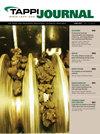级间筛分离生产板级BCTMP的节能潜力
IF 0.6
4区 农林科学
Q4 MATERIALS SCIENCE, PAPER & WOOD
引用次数: 0
摘要
在过去的几十年里,机械纸浆等级的持续下降导致纸浆生产商修改操作并采取措施降低生产成本,以保持竞争力。尽管在降低能源消耗方面做出了相当大的努力,但后者仍然是生产漂白化学热机械纸浆(BCTMP)过程中生产成本的主要部分。在这项研究中,我们评估了段间筛选分馏(ISSF)和二次精炼策略对生产BCTMP的影响,目的是在保持或提高体积和强度性能的同时降低精炼能耗。在第一步中,为了建立磨厂现有配置的基线,从ISSF收集的初级精炼纸浆和废渣流在高稠度(HC)精炼厂中精炼到目标游离水平。将收废液和精制废液重新组合,并与精制原浆的性能进行了比较。结果表明,在给定游离度为400 mL时,与对照病例(未分离)相比,ISSF使用0.070 in。在第二阶段的HC精炼中,采用篮式精炼后的废渣精炼可节省约25%的能源。手纸性能表明,利用ISSF可以得到体积较大、平均纤维长度和撕裂指数相近的BCTMP。然而,观察到拉伸强度略有降低。在第二组试验中,使用0.070 In的isf对初级精制纸浆和废渣进行预处理。用低浓度(LC)精制机精制。结果表明,在相同游离度为400 mL的情况下,与精制原浆相比,ISSF可节省约26%的LC净精炼能量。在0.4 J/m的特定边载荷(SEL)下,与对照样品相比,制备的纸浆具有相似的体积和强度特性。LC精炼的SEL提高到0.6 J/m,可以进一步降低净精炼能耗;然而,它也会导致纤维长度、体积和强度的减少。本文章由计算机程序翻译,如有差异,请以英文原文为准。
Energy saving potential of interstage screen fractionation for production of board grade BCTMP
Over the last few decades, the continuing decline in mechanical pulp-based grades has led pulp producers to modify operations and implement measures to reduce production costs in order to stay competitive. In spite of a considerable effort to reduce energy consumption, the latter is still a major portion of production costs in the process of making bleached chemithermomechanical pulp (BCTMP). In this study, we evaluated the impact of interstage screening fractionation (ISSF) and secondary refining strategy for producing BCTMP with the objective of reducing refining energy consumption while maintaining or improving bulk and strength properties.
In the first step and to establish a baseline for a mill’s existing configuration, the collected primary refined pulp and reject streams from the ISSF were refined in a high consistency (HC) refiner to target freeness levels. The accepts and refined rejects streams were recombined, and their properties were compared to those of the refined primary pulp. The results showed that, at a given freeness of 400 mL and compared to the control case (without fractionation), the ISSF using an 0.070 in. basket followed by rejects refining could lead to about 25% energy saving in the second stage HC refining. Handsheet properties showed that utilization of ISSF could produce BCTMP with higher bulk and similar average fiber length and tear index. However, a slight reduction in tensile strength was observed.
In the second set of trials, the primary refined pulp and the rejects from the ISSF using the 0.070 in. basket were refined by a low-consistency (LC) refiner. The results showed that, at the same freeness of 400 mL and compared to refined primary pulp, the ISSF saved about 26% in net LC refining energy. At a specific edge load (SEL) of 0.4 J/m, the produced pulp had similar bulk and strength properties compared to those of the control sample. A higher SEL of 0.6 J/m in LC refining could further decrease net refining energy consumption; however, it also led to reduction in fiber length, bulk, and strength properties.
求助全文
通过发布文献求助,成功后即可免费获取论文全文。
去求助
来源期刊

Tappi Journal
工程技术-材料科学:纸与木材
CiteScore
1.30
自引率
16.70%
发文量
59
审稿时长
6-12 weeks
期刊介绍:
An internationally recognized technical publication for over 60 years, TAPPI Journal (TJ) publishes the latest and most relevant research on the forest products and related industries. A stringent peer-review process and distinguished editorial board of academic and industry experts set TAPPI Journal apart as a reliable source for impactful basic and applied research and technical reviews.
Available at no charge to TAPPI members, each issue of TAPPI Journal features research in pulp, paper, packaging, tissue, nonwovens, converting, bioenergy, nanotechnology or other innovative cellulosic-based products and technologies. Publishing in TAPPI Journal delivers your research to a global audience of colleagues, peers and employers.
 求助内容:
求助内容: 应助结果提醒方式:
应助结果提醒方式:


